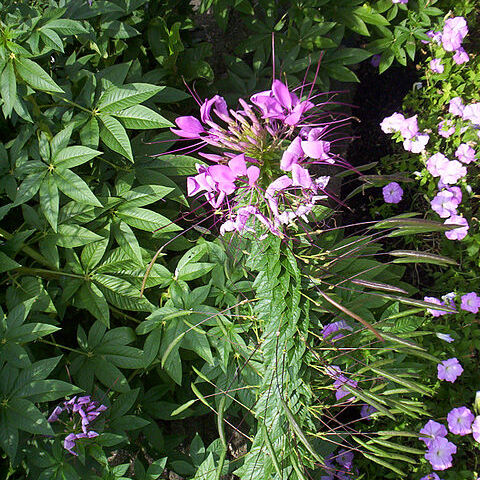Annual (or perennial) herbs, often hairy, sometimes glandular-hairy. Stipules none or obsolete; seldom with stiff, recurved, thorn-like, stipular (?) enations at the base of the leaf. Leaves petioled, herbaceous, in the Mal. spp. palmately dissected into 3-7 leaflets. Flowers pedicelled, in leafy, terminal racemes or panicles, the leaves apically gradually reduced, mostly slightly zygomorphic in the position of the petals. Sepals 4, free. Petals (normally) 4, the base often clawed. Stamens 6 to ∞, in Mal. spp. all fertile, sometimes at the base connate with the gynophore to an androgynophore. Disk small. Ovary 1-celled, sometimes sessile but mostly on a gynophore; stigma knob-shaped or flattish, subsessile. Capsule linear, terete, 2-valved, beaked, dehiscing from the base or from the apex, the 2 placentae forming a persistent replum. Seeds ∞, orbicular to horseshoe-shaped (with a more or less open cleft), sometimes with a funicular elaiosome, on the dorsal side sculptured to scaly.
Herbs, sometimes suffrutescent, rarely clambering, frequently glandular-pubescent or thorny; leaves alternate, stipulate or exstipulate, usually palmately compound, occasionally simple, the leaflets entire or minutely callose-serrulate; inflorescence racemose, terminal or both terminal and lateral, few-to many-flowered, bracteate, rarely ebracteate; calyx deeply 4-parted, persistent or decidu-ous; petals 4, more or less unequal, usually unguiculate; disc usually present, symmetrical or asymmetrical, rarely absent; stamens 6, rarely 4, inserted on a short or more or less elongate androgynophore, occasionally nearly sessile, the fila-*ments more or less unequal and declinate; ovary borne upon a more or less elongate gynophore, rarely nearly sessile, the stigma sessile or stipitate, the ovules numerous; fruit a dry, terete silique, dehiscing from the persistently joined replum by 2 valves; seeds cochleate-reniform, smooth, minutely tuberculate, or transversely rugose.
Herbs, annual or perennial. Stems unbranched or sparsely branched ; glandular-pubescent, glabrous, glabrescent, or scabrous. Leaves: stipules absent or scalelike; petiole with pulvinus basally or distally, (petiolule basally adnate, forming pulvinar disc); leaflets 1 or 3[-11] (flat). Inflorescences terminal or axillary (from distal leaves), racemes (flat-topped or elongated); bracts present [absent]. Flowers zygomorphic; sepals persistent, basally connate (1/2 of length), equal (each often subtending a nectary); petals equal; stamens [4] 6; filaments inserted on a discoid or conical androgynophore, glabrous; anthers (oblong to linear), coiling as pollen is released; gynophore recurved in fruit [obsolete]. Fruits capsules, dehiscent, oblong. Seeds 4-25, reniform or ovoid-spheroidal, arillate or not, (cleft fused between ends). x = 10 (?).
Herbs, mainly annual in East Africa, sometimes bushy and woody below. Leaves alternate, petiolate, simple or digitately compound with 3–5–7–9 very shortly petiolulate leaflets. Inflorescence racemose; flowers pedicellate, subtended by foliaceous or membranous, persistent or caducous bracts. Sepals 4, free or shortly united at the base. Petals 4, equal or unequal, often long-clawed. Androphore absent; stamens free; filaments equal or unequal, sometimes medially swollen; staminodes present or absent. Gynophore present or absent; ovary 1-locular with many parietal ovules. Fruit a siliquiform capsule with 2 dehiscing valves and a persistent replum. Seeds discoid or reniform, the ends incurving or one of them free; testa smooth, rugulose or ridged.
Pet equal or nearly so, entire; receptacle bearing an adaxial, usually rounded or pointed, mostly greenish or yellowish gland between the cor and the androecium; style mostly (incl our spp.) very short; frs usually long-stipitate, reticulately veined, opening from the base upwards, the valves deciduous; annuals with palmately compound or trifoliolate lvs, simple bracts, and handsome fls in elongating terminal racemes. 200, mainly warm reg.In addition to the following spp., the Middle-Eastern C. ornithopodioides L. is adventive on chrome ore piles in Ky. It is slender, to 5 dm, with strongly glandular stem, trifoliolate lvs (the lfls to 1.5 cm) and small fls (the pet only 1–2 mm) and frs (1.5–3.5 cm).
Annual or perennial herbs, glabrous or glandular-pubescent. Stipules usually absent. Leaves palmately dissected, of 3–7 leaflets. Flowers solitary-scapose or in terminal raceme. Sepals free, equal. Petals with or without claw, equal, often oriented to adaxial side. Stamens 1–30, sometimes connate with each other at base and adnate to gynophore to form androgynophore. Receptacular gland variable from concentric to unilateral. Gynophore present or absent; ovary unilocular with 2 placentas; stigma capitate. Fruit a capsule. Seeds many, orbicular to horseshoe-shaped, sculptured, with or without an aril.
Herbs, sometimes subshrubs. Lvs simple or digitate-compound. Fls solitary or in racemes, actinomorphic or subzygomorphic. Sepals 4, fused or free, persistent or caducous. Petals 4, sessile or clawed, equal or subequal. Stamens (4)-6-(10), free or adnate at base to form a short androgynophore; anthers usually exserted. Ovary on a gynophore; stigma sessile or style very short. Fr. a siliquiform capsule, glabrous or hairy. Seeds many, small, reniform.
Fruit an oblong or linear capsule often borne on an elongated gynophore, with two valves separating from the seed-bearing placentas, often tipped with the persistent style; valves glabrous or pubescent, smooth or strongly longitudinally nerved.
Stamens 2 — many, all fertile or some sterile, usually borne on a small torus or receptacle; filaments equal or unequal and declinate, occasionally thickened at the apex; anthers 2-thecous, usually oblong or narrowly oblong.
Ovary sessile or with a short gynophore, with many ovules on two parietal placentas; style short or absent; stigma capitate or truncate.
Leaves usually petiolate, simple or digitately 3–9-foliolate; leaflets usually narrow, linear to lanceolate, entire or serrulate.
Seeds reniform, smooth or ridged transversely, radially or longitudinally, or reticulate-tuberculate, glabrous or pubescent.
Sepals 4, usually free or almost so, usually narrow and often glandular or setulose-pubescent.
Annual or perennial herbs or occasionally small shrubs.
Petals 4, sessile or clawed, equal or unequal.
Flowers ± zygomorphic, in terminal racemes.

